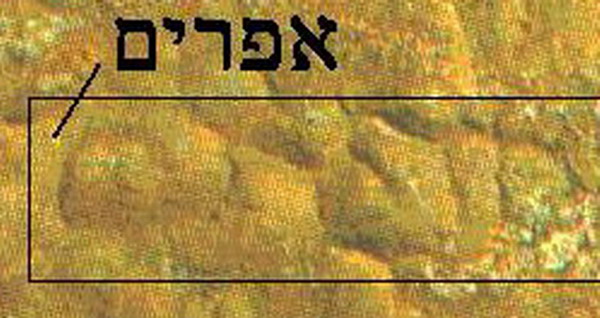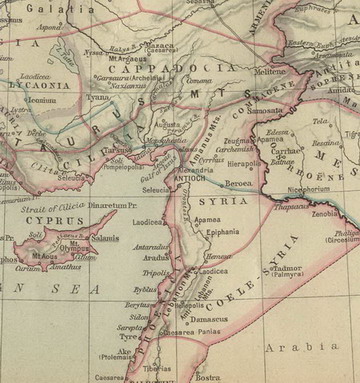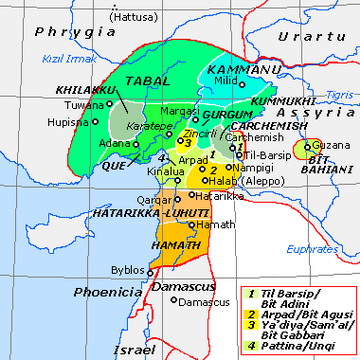BAMBINO (BRIT-AM BIBLICAL ISRAEL NEWS ONLINE)
Discussion of the Bible, Biblical History, Lost Israelite Tribes Identity in the Light of the Bible and other matters relating to Scripture.
BAMBINO no. 35
11 Sivan 5770, 24 May 2010
Contents:
1. Useful Article about Edom.
2. New Findings: Philistine Enclave in Northern Syria!
3. Ashkenaz
and Germany.
'Palestine existed in Syria, Turkey'
By JPOST.COM STAFF
11/05/2010 14:20
http://www.jpost.com/Israel/Article.aspx'id=175274
New finds from dig shed light on 11th, 12th century BC dynasty.
The great kingdom of 'Palestine' once existed within Syrian and Turkish
boundaries, a University of Tennessee professor claimed in a statement released
Tuesday.
Prof. J. P. Dessel, who is a member of the Tell Tayinat archeological digs in
Turkey and who presided at the Haifa University Ancient East Research
Conference, asserted that the commonwealth had been located between the cities
of Aleppo, Hama and Antakya, and the Turkish-Syrian border in the 12th and 11th
centuries BCE.
The find is significant because it indicates that the ancient Philistine empire
was not limited to the lands of Canaan.
Following the collapse of the Hittite dynasty in the 13th century BCE, smaller
states sprung up in areas that had previously been under Hittite rule ' one of
which was Palestine. In his lecture, Dessel explained that this had been
concluded from newfound evidence unearthed in the Tell Tayinat excavations.
Hittite hieroglyphics were found on the Antakya site, reading 'Palestine.'
Similar hieroglyphics were found in Aleppo and Hama.
'This is a significant discovery which shows that the Philistines did not just
hold land in Israel, but in Syria as well,' said Haifa University Prof. Gershon
Glil, the conference coordinator.
3.
Ashkenaz
and Germany
"In the Bible, Ashkenaz is Gomer's first son, brother of Riphath and
Togarmah (Gen. 10:3, 1 Chronicles 1:6)"
http://en.wikipedia.org/wiki/Ashkenaz
"It is difficult to determine when the term Ashkenaz was first applied to
Germany. In the Babylonian Talmud (Yoma 10a) the biblical Gomer, the father of
Ashkenaz, is rendered as "Germania," although in its original context the
reference is to Germanikia in northwestern Syria (cf. Gen. R. 37:1; TJ, Meg.
1:11, 71b). In addition to this incorrect identification, a possible source of
explanation may be in the name Scandza or Scanzia, the designation of
Scandinavia in several sources, which was regarded as the cradle of some
Germanic tribes. The association of Ashkenaz with Scandza is found as early as
the sixth century in the Latin addendum to the chronology of Eusebius. According
to another theory, the present connotation derives from the phonic resemblance
of "Ashkenaz" to "Saxons" who during the period of Charlemagne constituted the
predominant Germanic element in the Frankish kingdom. During the 11th and 12th
centuries the province incorporating Mainz and Worms was still known as "Lothar"
(Lotharingia; Rashi, Sefer ha-Pardes, 35:1; Tos. to bb 74a). The rabbis of
Regensburg were referred to as "Rabbanei Reinus" (i.e., "of the Rhine";
Responsum of Eliezer b. Nathan, in: She'elot u-Teshuvot Maharam mi-Rothenburg (Lemberg,
1860), no. 81). At the same time, however, the term "Ashkenaz" established
itself as the accepted Hebrew rendering of Germany. Thus in *Rashi's (1040'1105)
commentary on the Talmud, German expressions appear as leshon Ashkenaz (Suk.
17a; Git. 55b; BM 73b). Similarly when Rashi writes: "But in Ashkenaz I saw'" (Ket.
77b) he no doubt meant the communities of Mainz and Worms in which he had dwelt.
Thus also it is certain that such terms as Ere Ashkenaz appearing in his
commentaries (e.g., ul. 93a) represent Germany. *Eliezer b. Nathan (early 12th
century) distinguishes between Zarefatim (French) and Ashkenazim in reference to
the crusaders as "a foreign people, a bitter and impetuous nation" (A.M.
Habermann (ed.), Gezerot Ashkenaz ve- Zarefat (1946), 72). Letters from
Byzantine and Syrian communities written during the First Crusade also refer to
the crusaders as "Ashkenazim" (Mann, in: Ha-Tekufah, 23 (1925), 253, 256, 260).
http://www.jewishvir...02_0_01462.html
See also: http://www.search.co.../Ashkenazi_Jews
"The word Ashkenaz first appears in the genealogy in the Tanakh (Genesis 10) as
a son of Gomer and grandson of Japheth. It is thought that the name originally
applied to the Scythians (Ishkuz), who were called Ashkuza in Assyrian
inscriptions, and lake Ascanius and the region Ascania in Anatolia derive their
names from this group.
Ashkenaz in later Hebrew tradition became identified with the peoples of
Germany, and in particular to the area along the Rhine where the Alamanni tribe
once lived (compare the French and Spanish words Allemagne and Alemania,
respectively, for Germany).
The autonym was usually Yidn, however."
For Previous issues see:
Bambino Archives
To Make an Offering to Brit-Am
Send a check to
Brit-Am
POB 595
Jerusalem 91004
Israel
or deposit a donation in our
PayPal Account
http://britam.org/books.html#donate
Offering to Brit-Am
The name "Ephraim" in Hebrew Letters as Seen
by Satellite in the Hills of Ephraim

For Previous issues see:
BAMBINO ARCHIVE
Correspond with us
Send Comments or Criticisms
You may not always receive an immediate answer
but anything you say will be considered and appreciated
Send us an
e-mail
Books and Offering Opportunities
Main Page



